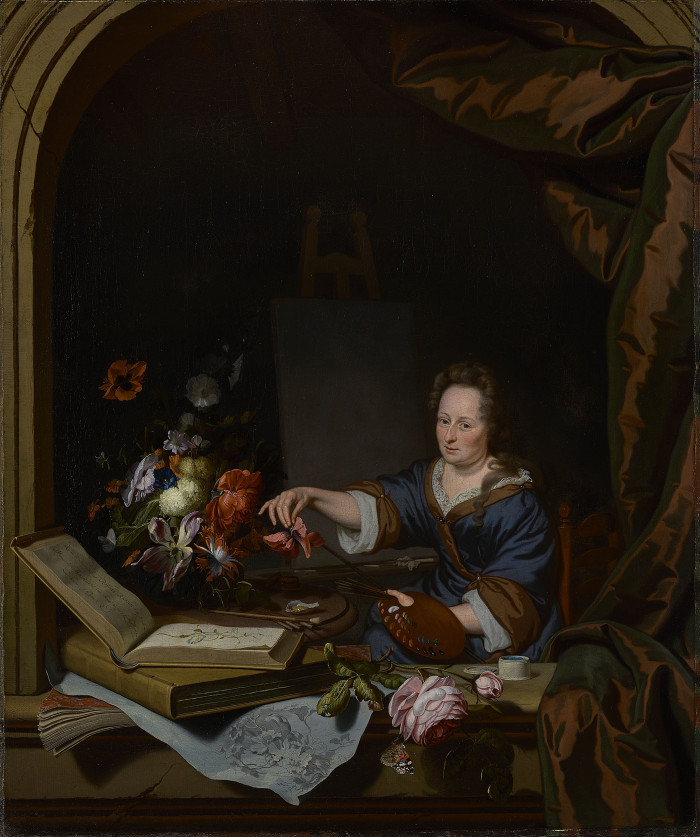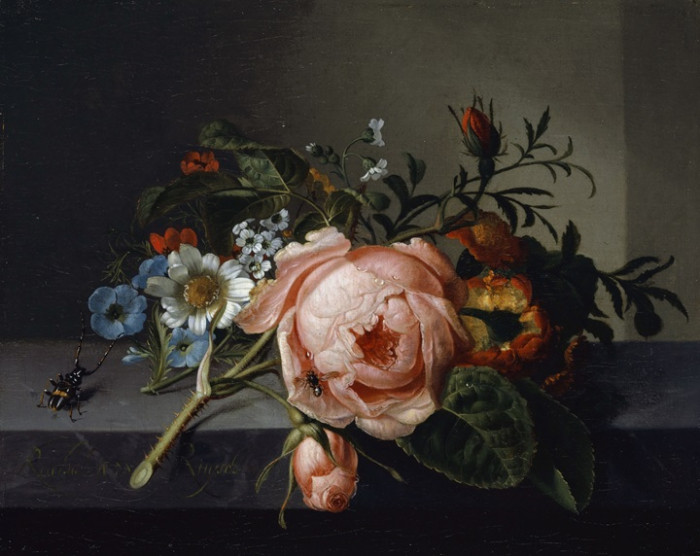The Toledo Museum of Art (TMA) presents Rachel Ruysch: Nature into Art, a landmark exhibition running from April 12 to July 27, 2025, that showcases for the first time one of the most celebrated painters of the 17th and 18th centuries. Featuring Ruysch’s masterful flower paintings alongside prints, drawings, illustrated books, and natural specimens, the exhibition explores her artistic achievements and the connections between art, science, and natural history.

Rachel Ruysch (Dutch, 1664–1750) and Michiel van Musscher (Dutch, 1645–1705), Rachel Ruysch (1664–1750). Oil on canvas, 1692. 30 x 25 in. (76.2 x 63.5 cm). Lent by the Metropolitan Museum of Art, Purchase, Adele Veronica Satkus Bequest, Walter and Leonore Annenberg Acquisitions Endowment Fund, Lila Acheson Wallace, Women and the Critical Eye, Charles and Jessie Price, and Henry and Lucy Moses Fund Inc. Gifts, Victor Wilbour Memorial Fund, Hester Diamond Gift, and funds from various donors, 2023 (2023.91)
“Renowned for her exquisite still-life paintings, Ruysch achieved exceptional fame in her time, garnering admiration for her masterful technique and her ability to intertwine the beauty of nature with scientific observation,” said Robert Schindler, William Hutton Curator of European Art at TMA and the Toledo exhibition’s curator. “Despite her exceptional career, Ruysch’s contributions to art history have been underexplored. Through this exhibition, we aim to shine a spotlight on her remarkable achievements and trace her illustrious career while exploring the rich connections in her work between art and science during the Scientific Revolution.”
Rachel Ruysch: Nature into Art brings together more than 100 loans from renowned national and international museums and private collections including 48 of Ruysch’s most important paintings to show alongside illustrated books, drawings, and botanical and zoological specimens to highlight her deep interest in the natural world and close study of nature.

Rachel Ruysch (Dutch, 1664–1750), Posy of Flowers, with a Beetle, on a Stone Ledge. Oil on canvas, 1741. 7 7/8 x 9 5/8 in. (20 x 24.5 cm). Kunstmuseum Basel, Inv. 1100, Gift of Prof. J. J. Bachofen-Burckhardt Foundation, 2015
Highlights include:
Several important Ruysch paintings from major international collections that have rarely or never been on public view before.
A reunion of Flower Still Life (c.1716–1720), from the TMA collection and its long-separated pendant, Still Life with Fruit, Bird’s Nest, and Insects (1716), from Dudmaston Hall in England. When TMA acquired Flower Still Life in 1956, it became the first U.S. museum to add a Ruysch to its collection.
Three portraits of Ruysch, including a family portrait with her husband and youngest son and a recently discovered portrait of the artist in her studio.
Works by Ruysch’s sister Anna, a talented but lesser-known flower painter, displayed alongside Rachel’s paintings.
“This exhibition not only celebrates Rachel Ruysch’s stunning artistry but also reflects the Toledo Museum of Art’s ongoing commitment to broadening the narrative of art history,” said Adam Levine, TMA’s Edward Drummond and Florence Scott Libbey Director, President, and CEO. “Ruysch’s legacy as a trailblazer and innovator is one that resonates deeply today, and we are honored to share her work with our visitors.”
Through immersive galleries, historical artifacts, and innovative scholarship, Rachel Ruysch: Nature into Art positions Ruysch as a key figure in the evolution of still-life painting and underscores the enduring relevance of her work. The exhibition is divided into five sections.
Section 1: Auspicious Beginning
Auspicious Beginning opens the exhibition with a selection of Ruysch’s most important paintings from the first decade of her work. To explore Ruysch’s influences, experimentation, and innovation, her early work hangs alongside paintings by her teacher Willem van Aelst and contemporary still-life painters such as Jan Davidsz de Heem, Otto Marseus van Schrieck, and Maria van Oosterwijck.
Section 2: Rachel and Anna
Few know that Ruysch had a younger sister, Anna, who was also a talented painter of floral still lifes. The early careers of the sisters seemed to unfold similarly. However, Anna eventually stopped painting. A group of Anna’s works will be displayed side by side with those of her sister, offering insight into their shared talent and divergent paths.
Section 3: Art, Nature, and Science
This section delves into Ruysch’s connection to the botanical and zoological science of the period. Frederik Ruysch, her father and a renowned anatomy and botany professor in Amsterdam, built a personal collection of natural specimens and shared it with the public. Through her father, Ruysch had access to Amsterdam’s botanical gardens, where she encountered both native and newly introduced plant species—many brought to Europe through exploration, trade, and colonization. Her paintings are masterpieces of artistic skill and scientific inquiry and reveal the profound ways in which art and science intertwined during the Scientific Revolution.
Section 4: Fame and Fortune
This section celebrates Ruysch’s most successful and productive years as an artist. In 1701, she became the first female member of the artist society Confrerie Pictura in The Hague. Then in 1708, she was appointed court painter to Johann Wilhelm, the Elector Palatine, in Düsseldorf and remained in his service until his death in 1716. During this period, Ruysch regularly painted full-of-detail, large, and ambitious bouquets of flowers displayed with luscious fruit and teeming with insects. Her work during this period cemented her reputation as one of the foremost floral still-life painters of all time.
Section 5: Heroine of Art
Ruysch continued to work into her 70s and 80s. She adopted a brighter palette and lighter backgrounds influenced by the time’s popular French Rococo style. Her later paintings were more modest in size and ambition, but her pride in her work is illustrated by her signature, the year, and her age.
This last section of the exhibition features an extraordinary drawing of Ruysch that was completed only months before her death in 1750. Her biography, written by Johan van Gool, was published that year, as was a collection of poems celebrating Ruysch and her accomplishments. Visitors can read a selection of these poems in this section of the exhibition.
Visitor Information
Rachel Ruysch: Nature into Art will be on view in the Levis Gallery from April 12 to July 27. Tickets are $10 per visitor and free for TMA members. General admission to the museum and parking are free to all visitors.
To enhance the Rachel Ruysch: Nature into Art exhibition, TMA will offer a range of interactive and educational experiences, such as:
An audio guide and audio description tour that features insights from Schindler; Megan Reddicks Pignataro, research associate in European art, TMA; and experts in botany and zoology.
An engaging digital interactive experience that maps the origins of some of the plant, insect, and animal species featured in Ruysch’s paintings.
Tactile and scent elements that bring Ruysch’s work to life.
A printed exhibition guide that provides deeper context.
Hands-on artmaking activities that invite guests to contribute to a communal still-life display.
Public programs, including docent-led tours, lectures, and special events, that examine Ruysch’s artistic techniques, her influence on still-life painting, and the cultural landscape of 17th- and 18th-century Dutch art.
In addition, a fully illustrated scholarly monograph published by MFA Publications will accompany the exhibition. Rachel Ruysch: Nature into Art is the first monograph in over 70 years to celebrate the work of Ruysch.
Rachel Ruysch: Nature into Art is organized by the Toledo Museum of Art in Ohio, the Museum of Fine Arts in Boston, and the Alte Pinakothek, Munich. Selldorf Architects in the Toledo Museum of Art’s exhibition design partner.
The Toledo exhibition is made possible with the generous support of Presenting Sponsors Susan and Tom Palmer; Season Sponsors Taylor Automotive Family and the Rita Barbour Kern Foundation; Platinum Sponsor Todd and Jeannie Peters, and the Zenith Foundation; Silver Sponsor TMA Ambassadors; and additional funding from the Ohio Arts Council, which receives support from the State of Ohio and the National Endowment for the Arts.